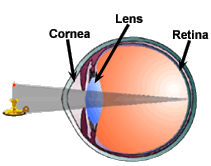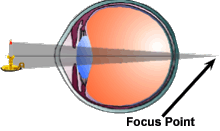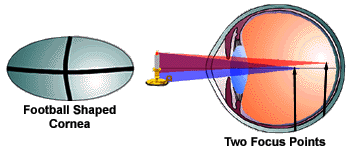

Nearsightedness

 Astigmatism
AstigmatismFor a comprehensive and
interactive treatment of the eye visit
http://www.yorku.ca/eye/thejoy.htm
Visit this site to learn of the history
of corrective lenses
http://www.ee.umd.edu/~taylor/optics2.htm
|
|
 Nearsightedness |
|
 Astigmatism Astigmatism |
The human eye is a marvelous manager of light rays. The function
of eye structures is summarized here
The cornea is transparent tissue that serves as an outer covering
for the eye and is the place where much (70-80%) of the refraction
for the eye takes place.
The iris regulates the amount of light entering the pupil
by altering the size of the aperture (pupil) through which
the light passes.
The lens is double convex and gelatinous, its shape being
controlled by ciliary
muscles in order to fine-tune a sharp
image. The process by which the lens changes shape to sharpen
the retinal image is called accommodation. Click
here for a demonstration.
The retina at the back wall of the eye is the place where
incoming rays(or waves or photons,take your pick) strike rods and cones
that convert light energy into electrical impulses that are sent
to the brain for analysis.
While it will always be a marvelous construction, the eye from time to time does malfunction. The most common eye disorder is nearsightedness,more commonly known as myopia . There are two schools of thought on the cause of myopia. Some suggest that it is hereditary and exists because the eyeball slightly longer than it should be. In the other theory it is held that behavior, specifically great amounts of close work, weaken the ciliary muscles so that the eye cannot focus things are far away. In either case, the image comes to a focus in front of the retina . See the diagram above. The condition can be corrected by a diverging lens, most often a meniscus concave (a.k.a. convexo-concave). Such a lens in a spectacle frame is an imposing piece of glass or plastic being much thicker at the edge than at the center. The reader shoiuld note that the glass is this thickness mostly for its own safety--well beyond being shatter-prone. A soft contact lens is fashioned as meniscus concave and is called hydrophilic,literally "water-loving", because it has 40% water composition. This small wisp of plastic soaked in saline does all of the additional refraction necessary to put a sharp image on the retina.
People who are extremely myopic may need the refractive power of a double concave lens/ Many years ago, Congress saw fit to give people who are functionally blind an additional tax exemption
| Formally, a person is legally blind if their central vision acuity is 20/200 or less in the better eye, even with corrective lenses; or if they have central vision acuity of more than 20/200 if the peripheral field is restricted to a diameter of 20 degrees or less. Informally, those who, even with corrective lenses, cannot read the biggest letter on an eye chart are considered to be legally blind. -------The Braille Institute |
Visit these sites for a comprehensive
look at myopia.
http://www.oregoneyecenter.com/myopia.htm
http://www.allaboutvision.com/conditions/myopia.htm
Astigmatism is a condition arising from
asymmetry of the cornea; instead of being spherical, it is shaped
more nearly like a football. See the diagram above. Once again,
corrective lenses come to the rescue, although prescribing the
correct configuration for the lens is not easy.
Learn more about astigmatism at
http://www.allaboutvision.com/conditions/astigmatism.htm
This page was last reviewed by mgosselin 10/09/2005